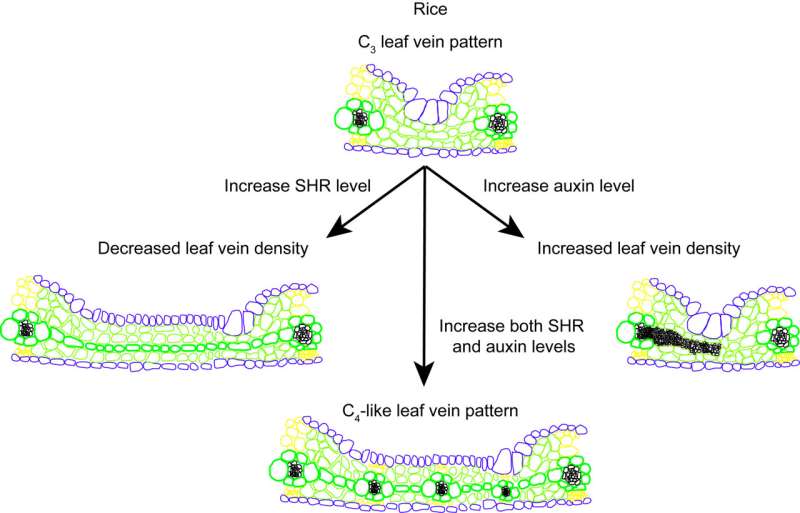This article has been reviewed according to Science X's editorial process and policies. Editors have highlighted the following attributes while ensuring the content's credibility:
fact-checked
trusted source
proofread
Creating a C4-like vein pattern in rice by manipulating SHORT ROOT and auxin levels

C4 plants are distinguished by a unique leaf structure known as Kranz anatomy, characterized by inner vascular bundle sheath cells and outer mesophyll cells. This specialized arrangement confers C4 plants with several advantages over C3 plants, including higher photosynthetic rates and superior nitrogen and water use efficiency.
This Kranz structure not only defines C4 plant leaves but also represents a pivotal characteristic in the transition from C3 to C4 photosynthesis. Increasing vascular bundle density has long been believed to be a key initial step in C4 plant evolution. However, the regulatory mechanisms governing leaf vein density have remained elusive.
The SHR gene encodes a transcription factor that has been previously shown to regulate root cortex development and nodule formation in legumes. Intriguingly, this study unveils a novel role of SHR in modulating vascular bundle density in leaves. Specifically, mutations in the SHR gene inhibit mesophyll cell division and increase leaf vein density in both rice and maize.
Conversely, overexpression of SHR from various plant species (including alfalfa, rice, and maize) robustly stimulates mesophyll cell division and substantially reduces leaf vein density in rice and maize. Moreover, SHR proteins localize to both bundle sheath and mesophyll cells in rice and maize, with increased native SHR expression recapitulating the phenotype of SHR overexpression lines.
These findings indicate an inverse relationship between SHR protein abundance and leaf vein density. Additionally, exogenous auxin treatment enhances leaf vein formation in rice. Intriguingly, by simultaneously increasing SHR and auxin levels in rice leaves, the researchers have successfully created C4-like vein patterning in rice.
Many previous studies have shown that both SHR and auxin levels experience a significant increase in C4 tissues as compared to C3 tissues. In combination with the results of this study, the authors propose that synergistic upregulation of SHR and auxin may be the key driver for the shift from C3 to C4 vascular bundle patterns in monocots.
From an evolutionary perspective, concomitant increases in SHR and auxin could have conferred both enhanced mesophyll cell growth and accelerated vein differentiation rates in C4 monocots relative to C3 ancestors.
In summary, these findings shed light on the antagonistic interplay between SHR and auxin, providing critical insights into C4 vein formation and potentially opening up an exciting avenue for enhancing the photosynthetic efficiency of C3 crops.
The research is published in the journal Science Bulletin.
More information: Wentao Dong et al, Creating a C4-like vein pattern in rice by manipulating SHORT ROOT and auxin levels, Science Bulletin (2023). DOI: 10.1016/j.scib.2023.10.005
Provided by Science China Press




















